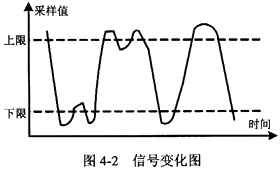问题
单项选择题
RMON警报组的实现是基于 (1) 的实现。当RMON警报组alarmStartupAlam=3时,在图4-2所示的信号变化图上,将产生 (2) 次的报警。

2()
A.3
B.5
C.6
D.9
答案
参考答案:C
解析:
在RMON功能组中,①警报组的实现基于事件组的实现;②捕获组的实现基于过滤组的实现:③最高N台主机组的实现基于主机组的实现。
当RMON警报组alarmStartupAlam=3时,其报警规则是:①当第一个采样值大于上升门限时,要产生1次报警;②当采样值从大于上升门限值降到小于下降门限时,要产生1次报警;③当采样值从小于下降门限值上升至大于上升门限时,要产生1次报警;④当采样值从小于下降门限值上升到正常值范围,然后又下降到下降门限时,不产生报警:⑤当采样值从大于上升门限值下降到正常值范围,然后又升回到上升门限时,不产生报警。因此,在图4-2所示的报警信号变化图上,将产生6次的报警信息。
